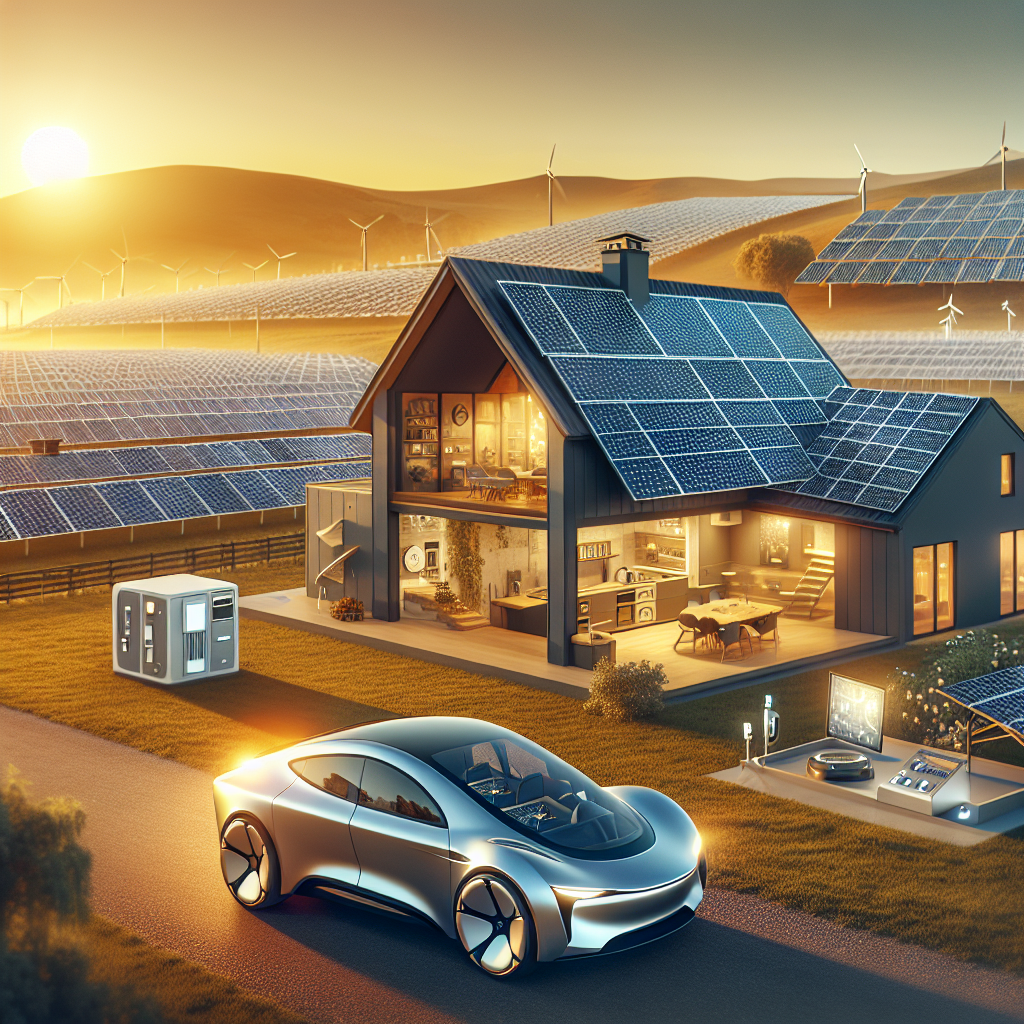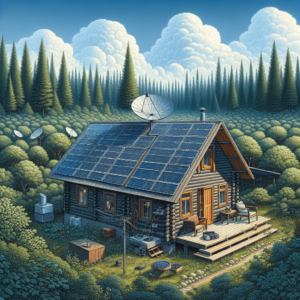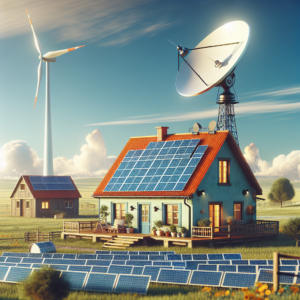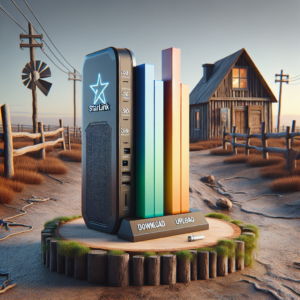
When it comes to harnessing the power of the sun, going off-grid with solar solutions is like planting your own vegetable garden – it’s all about self-reliance and sustainability. You’re not just saving money, you’re taking control of your energy needs and saying goodbye to those ever-fluctuating utility bills.
But let’s get something straight – diving into the world of off-grid solar isn’t just about buying a bunch of panels and slapping them on your roof. It’s about understanding your energy consumption, the solar potential of your location, and piecing together a system that’s as unique as your home.
Key Takeaways
-
Off-grid solar solutions offer energy independence and can be tailored to any home.
-
Understanding your energy consumption is the first step to designing an off-grid system.
-
Location plays a crucial role in the efficiency and design of your solar setup.
-
Key components of an off-grid system include solar panels, batteries, inverters, and charge controllers.
-
Maintenance and monitoring are essential for maximizing the lifespan and efficiency of your system.
What is Off-Grid Solar?
Imagine a camping trip where you’re away from the convenience of a power outlet, yet you have all the electricity you need. That’s off-grid solar in a nutshell. It’s a standalone power system that lets you live and thrive without relying on a utility grid. This means every ounce of power you use comes from the sun, and it’s all yours, free and clear.
Is Off-Grid Right for You?
Before we dive into the nuts and bolts, let’s figure out if off-grid solar is a good match for you. If you cherish independence and are ready for the responsibility that comes with maintaining your own energy system, you’re on the right track. Off-grid solar is perfect for homes in remote locations without reliable access to the grid. But it’s not just for the rural homesteader; urban dwellers with a passion for sustainability are also joining the off-grid movement.
Decoding Your Energy Needs
Assessing Your Daily Power Consumption
The first step in your off-grid journey is to understand how much energy you actually use. It’s like figuring out how much food you need to grow in that garden we talked about. Grab your utility bills from the past year, and let’s crunch some numbers. Look for your monthly kilowatt-hour (kWh) usage – this tells us how much power you consume and will guide us in sizing your solar system.
Understanding the Role of Location in Solar Efficiency
Just like some plants need more sunlight than others, your location determines how much solar energy you can harvest. Factors like the number of sunny days, the angle of the sun, and even the local climate play a huge role. If you’re in a sunny state like Arizona, you’ll need fewer panels than if you’re in a cloudier place like Washington.

Building Blocks of an Off-Grid Solar System
-
Solar Panels: These are your energy harvesters, turning sunlight into electricity.
-
Batteries: They store the solar power for when the sun isn’t shining.
-
Inverters: These convert the solar energy into a form that can power your home appliances.
-
Charge Controllers: They protect your batteries from being overcharged or drained too low.
Each piece of the puzzle is critical, and getting the right setup for your needs is where the magic happens. It’s like a recipe – the right ingredients, in the right amounts, make all the difference.
Solar Panels: Your Energy Harvesters
Think of solar panels as the workers in your garden – they’re out there every day, capturing sunlight and converting it into something useful. The number and type of panels you need depend on your energy consumption and the amount of sunlight your location receives. We’re talking about watts, efficiency, and square footage – the real deal.
But don’t worry, you don’t need to be a solar engineer to get this right. There are tools and experts that can help you calculate exactly what you need based on your energy audit and location. Besides that, solar technology has come a long way, and there are options for every budget and scenario.
Batteries: Storing Your Solar Bounty
Now, let’s talk storage. Batteries are like the pantry of your solar system – they keep your harvested energy ready and waiting. But not all batteries are created equal. You’ve got lead-acid, lithium-ion, and even saltwater batteries to choose from. Each has its own pros and cons, like cost, capacity, and lifespan.
Choosing the right batteries is about more than just price; it’s about finding the sweet spot for your energy needs and lifestyle. For instance, lithium-ion batteries might cost more upfront, but their longer lifespan and better performance might make them the more economical choice in the long run.
Inverters: Converting Sunlight to Usable Power
After your solar panels do their job, it’s the inverter’s turn to shine. This device is the heart of your power system, taking the direct current (DC) electricity from your panels and transforming it into alternating current (AC) electricity. Why is this important? Because AC is the type of power that runs your fridge, lights, and TV – basically everything in your home. So, picking a high-quality inverter is like choosing a reliable heart surgeon – it’s vital.
Charge Controllers: Protecting Your Power Supply
Charge controllers are the guardians of your solar system. They stand watch over your batteries, ensuring they’re not overcharged during the day or drained too much at night. A good charge controller increases the lifespan of your battery storage, saving you money and hassle in the long run. It’s like having a smart thermostat for your home’s heating – it keeps things at the perfect temperature without wasting energy.
Designing Your Custom Off-Grid Solution
Now that we’ve covered the components, it’s time to design your off-grid solar system. This isn’t a one-size-fits-all situation; it’s about creating a system that fits your specific needs like a tailored suit. And the key to a perfect fit is starting with a solid foundation – your energy needs assessment.
Calculating the Right System Size
To size your system correctly, you need to know two things: how much energy you use and how much sunlight your location gets. It’s a bit like a budget – if you spend more than you make, you’re in trouble. So, we aim to create a system that produces just the right amount of power for your needs.
Take the total kWh from your energy audit and match that with the solar potential in your area. This will give you the number of kilowatts your system needs to produce. And remember, it’s better to err on the side of a little too much power than not enough. After all, having a few extra jars of home-canned tomatoes come winter is never a bad thing.
Selecting Components That Fit Your Lifestyle
Choosing components for your off-grid system is like picking out ingredients for a gourmet meal. You want the best quality that your budget allows, and you need to consider how each component works with the others. Do you need a system that’s low-maintenance? Are you planning to expand your system in the future? These are the kinds of questions that will guide your choices.

Installation Insights: The Path to Energy Independence
With your components selected, it’s time to roll up your sleeves and get to the installation. Whether you go DIY or hire a professional, the key is to ensure everything is set up safely and efficiently. A well-installed solar system not only performs better but also lasts longer – much like a well-built home.
DIY vs. Professional: Choosing Your Installation Path
If you’re the hands-on type, a DIY installation can be a rewarding project. But, it’s crucial to know your limits. If you’re not comfortable working with electrical systems, hiring a professional is the smart move. They’ll make sure your system is up to code and running smoothly, giving you peace of mind along with your new energy independence.
Maintaining Your Off-Grid Solar System
Once your system is up and running, maintenance is what keeps it humming along. Checking connections, cleaning panels, and monitoring your batteries are all part of the routine. Think of it like caring for a garden – a little bit of regular attention goes a long way toward a bountiful harvest.
Real-Life Off-Grid Brilliance
Let me share a story that perfectly illustrates the potential of off-grid solar. A friend of mine lives in a remote cabin in the mountains. She used to rely on a noisy, gas-guzzling generator for power. But since switching to an off-grid solar system, she enjoys the sounds of nature instead of the drone of an engine. Her solar setup includes a modest array of panels, a reliable battery bank, and a trusty inverter, all tailored to her modest energy needs. It’s a beautiful example of how off-grid solar can change lives.
Example: John and Jane Doe from Vermont transitioned their family home to a fully off-grid solar system. They invested in high-capacity batteries to store excess power for their long winters. Now, they not only enjoy reduced energy costs but also have the security of knowing they’re prepared for any power outages.
Stories like these are becoming more common as solar technology improves and becomes more accessible. And remember, off-grid solar isn’t just for remote cabins or eco-warriors; it’s for anyone looking to take control of their energy future.
Showcase: Tiny Homes and Cozy Cabins
Tiny homes are all the rage, and many owners are turning to off-grid solar to power their pint-sized abodes. With a smaller footprint, tiny homes require less energy, making off-grid solar a perfect match. Plus, the flexibility of solar panels means they can be installed in a variety of configurations to maximize exposure to the sun.
Cozy cabins tucked away in the woods are also prime candidates for off-grid solar. Without the need to connect to the grid, cabin owners can enjoy modern comforts while surrounded by nature. And with advancements in solar technology, even the shortest days of winter can be met with ample power.
Van Life: Solar on the Move
For those with a nomadic spirit, off-grid solar offers the freedom to roam without leaving a carbon footprint. Van lifers are equipping their mobile homes with solar panels, batteries, and inverters to power their adventures. It’s a sustainable way to explore while keeping the lights on and the fridge cold, no matter where you park.
In conclusion, off-grid solar solutions are not a one-size-fits-all proposition. They’re a highly customizable and sustainable way to meet your energy needs, whether you’re in a tiny home, a cozy cabin, or living the van life. By understanding your energy needs, choosing the right components, and maintaining your system, you can enjoy the freedom and independence that off-grid solar brings. And remember, whether you choose to DIY or go with a professional, the key is to ensure a safe and efficient setup that will serve you for years to come.
Your Energy Harvesters -Delete from here
Think of solar panels as the workers in your garden – they’re out there every day, capturing sunlight and converting it into something useful. The number and type of panels you need depend on your energy consumption and the amount of sunlight your location receives. We’re talking about watts, efficiency, and square footage – the real deal.
But don’t worry, you don’t need to be a solar engineer to get this right. There are tools and experts that can help you calculate exactly what you need based on your energy audit and location. Besides that, solar technology has come a long way, and there are options for every budget and scenario.
Batteries: Storing Your Solar Bounty
Now, let’s talk storage. Batteries are like the pantry of your solar system – they keep your harvested energy ready and waiting. But not all batteries are created equal. You’ve got lead-acid, lithium-ion, and even saltwater batteries to choose from. Each has its own pros and cons, like cost, capacity, and lifespan.
Choosing the right batteries is about more than just price; it’s about finding the sweet spot for your energy needs and lifestyle. For instance, lithium-ion batteries might cost more upfront, but their longer lifespan and better performance might make them the more economical choice in the long run.
Inverters: Converting Sunlight to Usable Power
After your solar panels do their job, it’s the inverter’s turn to shine. This device is the heart of your power system, taking the direct current (DC) electricity from your panels and transforming it into alternating current (AC) electricity. Why is this important? Because AC is the type of power that runs your fridge, lights, and TV – basically everything in your home. So, picking a high-quality inverter is like choosing a reliable heart surgeon – it’s vital.
Charge Controllers: Protecting Your Power Supply
Charge controllers are the guardians of your solar system. They stand watch over your batteries, ensuring they’re not overcharged during the day or drained too much at night. A good charge controller increases the lifespan of your battery storage, saving you money and hassle in the long run. It’s like having a smart thermostat for your home’s heating – it keeps things at the perfect temperature without wasting energy.
Designing Your Custom Off-Grid Solution
Now that we’ve covered the components, it’s time to design your off-grid solar system. This isn’t a one-size-fits-all situation; it’s about creating a system that fits your specific needs like a tailored suit. And the key to a perfect fit is starting with a solid foundation – your energy needs assessment.
Calculating the Right System Size
To size your system correctly, you need to know two things: how much energy you use and how much sunlight your location gets. It’s a bit like a budget – if you spend more than you make, you’re in trouble. So, we aim to create a system that produces just the right amount of power for your needs.
Take the total kWh from your energy audit and match that with the solar potential in your area. This will give you the number of kilowatts your system needs to produce. And remember, it’s better to err on the side of a little too much power than not enough. After all, having a few extra jars of home-canned tomatoes come winter is never a bad thing.
Selecting Components That Fit Your Lifestyle
Choosing components for your off-grid system is like picking out ingredients for a gourmet meal. You want the best quality that your budget allows, and you need to consider how each component works with the others. Do you need a system that’s low-maintenance? Are you planning to expand your system in the future? These are the kinds of questions that will guide your choices.







